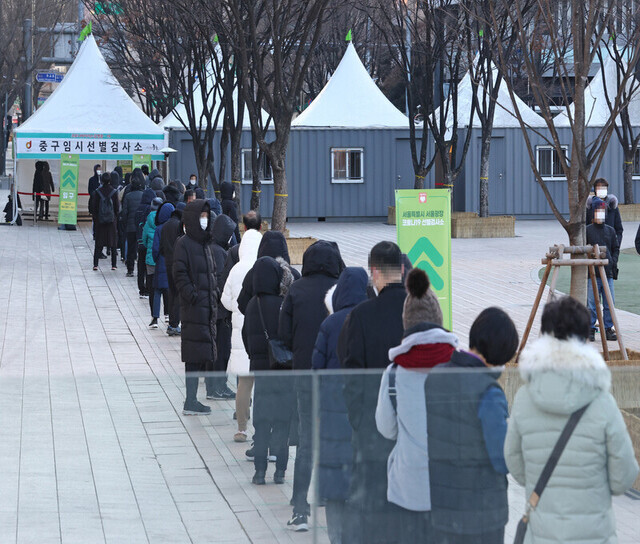hankyoreh
Links to other country sites 다른 나라 사이트 링크
Disparities driven by COVID-19 worse than those of past economic crises

Disparities between and within countries are more severe and widespread amid the COVID-19 pandemic than during the 1997 Asian financial crisis and the global financial crisis of 2007-2008, according to the Bank of Korea (BOK).
In an issue report titled “An Assessment of Growth Imbalances in the Wake of the COVID-19 Crisis” published on Dec. 21, BOK observed, “The COVID-19 crisis is an example of a public health crisis leading to an economic crisis. The shockwaves that have extended throughout the world have exacerbated disparities between countries and industries more so than during past crises.”
According to BOK, the disparities between countries can be characterized as imbalances between advanced and emerging economies and between information technology (IT) exporters and the rest of the world. While the advanced economies have been working toward economic recovery through proactive disease management and bold stimulus packages, emerging economies have struggled in their COVID-19 response and can’t afford widespread stimulus packages.
Tech has been a major driver of disparities between countries. Manufacturing in tech-heavy countries like China and Taiwan has already recovered to pre-pandemic levels. IT has also driven recovery in South Korea, BOK observed. In contrast, countries that rely heavily on tourism and raw material exports not only suffered greater losses but were predicted to have a slower economic recovery.
Even within countries, the pandemic asymmetrically affected different industries. Service industries saw a massive reduction in revenue and employment due to their reliance on physical interaction with consumers. Between the outbreak of the pandemic and the third quarter, consumption in service sectors like hospitality, dining, and travel decreased rapidly in the US, Germany, Japan, and South Korea. In contrast, the decline in the consumption of goods was relatively small. The US, Europe, and South Korea all saw major decreases in employment and interactive services.
Regarding disparities within countries, BOK spotlighted “the persistent gap between the real economy and the financial sector.” In most major economies, the real economy failed to recover in terms of employment and consumption, but financial markets have rebounded swiftly. Author Park Chang-hyeon said, “South Korea has resembled other major economies in that its financial sector has recovered faster than the real economy.”
“This is different from the past financial crises, where stock prices and the real economy showed similar patterns,” he noted.
BOK warned that “growth disparities between sectors of the domestic economy could delay economic recovery in the short term, combining with growing unemployment and falling asset prices to transform into a shock to the financial sector.”
By Kim Young-bae, staff reporter
Please direct comments or questions to [english@hani.co.kr]

Editorial・opinion
![[Column] Welcome to the president’s pity party [Column] Welcome to the president’s pity party](https://flexible.img.hani.co.kr/flexible/normal/500/300/imgdb/original/2024/0515/3917157400447943.jpg) [Column] Welcome to the president’s pity party
[Column] Welcome to the president’s pity party![[Editorial] Korea must respond firmly to Japan’s attempt to usurp Line [Editorial] Korea must respond firmly to Japan’s attempt to usurp Line](https://flexible.img.hani.co.kr/flexible/normal/500/300/imgdb/original/2024/0514/2317156736305813.jpg) [Editorial] Korea must respond firmly to Japan’s attempt to usurp Line
[Editorial] Korea must respond firmly to Japan’s attempt to usurp Line- [Editorial] Transfers of prosecutors investigating Korea’s first lady send chilling message
- [Column] Will Seoul’s ties with Moscow really recover on their own?
- [Column] Samsung’s ‘lost decade’ and Lee Jae-yong’s mismatched chopsticks
- [Correspondent’s column] The real reason the US is worried about Chinese ‘overcapacity’
- [Editorial] Yoon’s gesture at communication only highlights his reluctance to change
- [Editorial] Perilous stakes of Trump’s rhetoric around US troop pullout from Korea
- [Guest essay] Preventing Korean Peninsula from becoming front line of new cold war
- [Column] The state is back — but is it in business?
Most viewed articles
- 1[Column] Welcome to the president’s pity party
- 2Could Korea’s Naver lose control of Line to Japan?
- 3[Editorial] Korea must respond firmly to Japan’s attempt to usurp Line
- 4[Editorial] Transfers of prosecutors investigating Korea’s first lady send chilling message
- 5[Column] Will Seoul’s ties with Moscow really recover on their own?
- 6Major personnel shuffle reassigns prosecutors leading investigations into Korea’s first lady
- 7Naver’s union calls for action from government over possible Japanese buyout of Line
- 8US has always pulled troops from Korea unilaterally — is Yoon prepared for it to happen again?
- 9[Photo] Korean students protest US complicity in Israel’s war outside US Embassy
- 10Second suspect nabbed for gruesome murder of Korean in Thailand, 1 remains at large